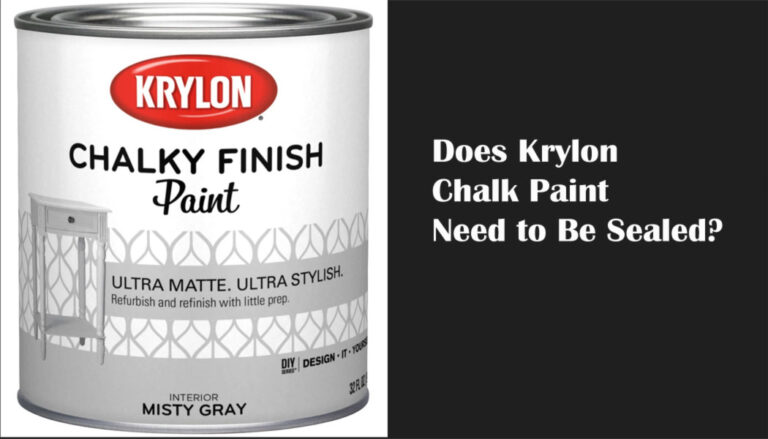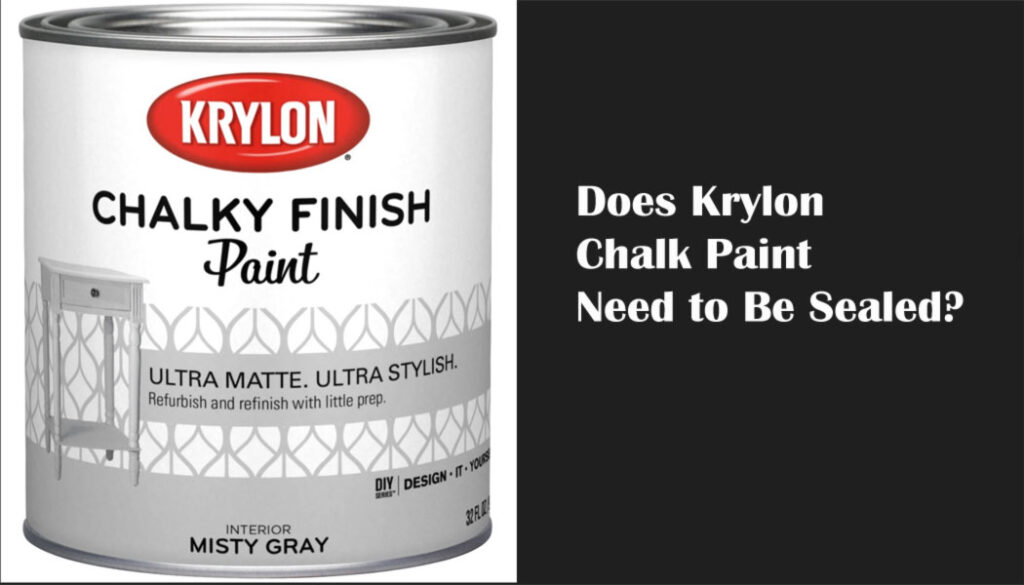
Does Krylon Chalk Paint Need to Be Sealed?
Have you ever wondered if Krylon Chalk paint needs to be sealed to ensure a long-lasting and flawless finish? This paint has gained popularity among DIY enthusiasts for its ability to transform surfaces into a trendy, matte finish reminiscent of vintage chalkboards. However, the question often arises – does krylon chalk paint need to be sealed?
Generally, Krylon Chalk paint doesn’t require sealing. But adding a protective sealer can offer some advantages and extend the lifespan of your chalk painted surface.

In this article, we will delve into this topic, exploring the benefits and considerations of sealing chalk paint from Krylon.
Is Krylon Chalky Paint the Same as Chalk Paint?
Krylon Chalky paint and chalk paint are not the same. While they both have a chalky, matte finish, they are produced by different manufacturers. Krylon Chalky paint is a specific brand of paint produced by Krylon, known for its durability and suitability for various surfaces.
On the other hand, chalk paint is a generic term used to describe a type of paint that has a chalky appearance. It can be easily distressed for a vintage or shabby chic look. It is typically associated with brands like Annie Sloan and Rust-Oleum.
Also Read: Chalk Paint over Thermofoil Cabinets?
Does Krylon Chalk Paint Need to Be Sealed?
Yes, Krylon Chalk paint generally needs to be sealed to protect the painted surface and enhance its durability. While the chalk paint itself offers a matte, chalky finish, it is not inherently resistant to moisture, stains, or abrasion. Sealing the paint provides an additional protective layer that helps preserve the painted surface over time.
There are a few reasons why sealing Krylon Chalk paint is recommended. Take a look.
Protection: Sealing the paint creates a barrier that safeguards it against various elements including water, UV rays, dirt, and everyday wear and tear. This protection helps prevent the paint from chipping, peeling, or fading. Additionally, it makes the surface more durable and long-lasting.
Improved Cleanability: The sealer enhances the cleanability of the painted surface. It forms a smooth and easier-to-clean finish, allowing you to wipe away dirt, spills, or stains easily. This is particularly important for surfaces that are frequently touched or exposed to moisture, such as furniture, cabinets, or kitchen countertops.
Enhancing Color and Finish: Sealing the chalk paint can enrich its color and appearance. Some sealers have the ability to deepen the hue of the paint, intensifying its richness. Moreover, the sealer can provide a subtle sheen or satin finish if desired, altering the original matte look of the chalk paint.
Longevity: By sealing the paint, you extend its lifespan and ensure that the painted surface maintains its beauty for an extended period. Sealing helps prevent premature fading or deterioration. It keeps the surface fresh and vibrant over time.
Next Read: Using Chalk over Oil-based Paint
What Are the Risks if Krylon Chalk Paint Not Sealed?
If chalk paint is not sealed, there are several potential risks.
Vulnerability to damage: Chalk paint without a sealant is more susceptible to scratches, and general wear and tear. It may not hold up well to regular use or cleaning.
Staining and discoloration: Unsealed chalk paint can absorb liquids and stains, leading to discoloration and a loss of the desired finish. Spills or exposure to moisture can result in permanent marks on the painted surface.
Limited durability: Without a sealant, the paint may not have sufficient protection against fading, peeling, or cracking. Sunlight, humidity, and other environmental factors can degrade the paint over time.
Difficulty with cleaning: Unsealed chalk paint tends to be more challenging to clean. Dust and dirt can become embedded in the porous surface.
Lack of longevity: The absence of a sealant can shorten the lifespan of the painted surface. The paint may deteriorate more quickly, requiring frequent touch-ups or complete repainting.
Sealing Options for Krylon Chalk Paint
To seal chalk paint, you have a few options: wax, polyurethane, or varnish. Each method provides protection and durability. Test it on a small area first for compatibility.
1. Wax: Applying a clear wax over the painted surface is a common method to seal and protect chalk paint. Use a clean brush to apply a thin, even layer of wax. Allow it to dry for the recommended time specified on the wax packaging. Finally, use a clean cloth to buff the wax, creating a smooth and protective finish.
2. Polyurethane: You can also use water-based polyurethane to seal chalk paint. Choose clear, water-based polyurethane specifically designed for use over painted surfaces. Apply the polyurethane using a clean brush or roller, following the manufacturer’s instructions for drying time.
3. Varnish: Another option is using a clear varnish to seal the chalk paint. Select a varnish suitable for protecting painted surfaces. Apply it evenly over the painted area using a brush. Multiple coats may be necessary for optimal protection.
How to Seal Krylon Chalk Paint Easily?
By properly sealing your chalk-painted surface, you can protect it from wear and tear while enhancing its longevity. Here’s how you can easily seal your Krylon Chalk paint for a beautiful finish.
Materials you need:
- Krylon Chalk paint
- Soft-bristle paintbrush
- Clean, lint-free cloth
- Sandpaper
- Krylon Chalky Finish Clear Sealer
Step 1: Prepare the surface
Ensure that the surface you’re painting is clean and dry. If necessary, sand the surface lightly with sandpaper to create a smooth and even base.
Step 2: Apply Krylon Chalk paint
Ensure proper blending of the Krylon paint by stirring it thoroughly until a uniform texture is achieved. Submerge the brush into the paint, and then eliminate any surplus by lightly tapping it against the side of the paint container. Apply the paint in smooth, even strokes, following the grain of the surface. Allow ample time for the paint to dry thoroughly.
Step 3: Assess the finish
Once the paint is dry, evaluate the finish. If you’re satisfied with the appearance, you can proceed to the next step. However, if you prefer a more distressed or weathered look, you can lightly sand the painted surface with fine-grit sandpaper to achieve the desired effect.
Step 4: Apply the clear sealer
Shake the Krylon Chalky finish clear sealer well before using it. Using a clean brush, apply a thin and even layer of the sealer over the painted surface. Work in small sections and brush in long, smooth strokes. Avoid excessive brushing, as it may disturb the paint beneath.
Step 5: Let it dry
Allow the sealer to dry according to the manufacturer’s instructions. This typically takes a few hours. However, it’s advisable to wait for at least 24 hours to ensure proper curing.
Step 6: Assess the sealed finish
Once the sealer is completely dry, inspect the sealed surface for any missed spots or imperfections. If necessary, apply an additional coat of the clear sealer to ensure even coverage and protection. Allow the final coat to dry thoroughly.
Tips for Successful Sealing Krylon Chalk Paint
Here are some tips for successfully sealing chalk paint.
- Clean and prepare the surface thoroughly before painting to ensure proper adhesion of the paint and sealer.
- Use a soft-bristle paintbrush or foam brush for a smooth and even application of both the paint and sealer. Avoid using brushes with stiff bristles.
- Apply thin coats of paint to prevent drips and buildup. Multiple thin coats are better than one thick coat, as it allows for better control and faster drying.
- Allow sufficient drying time between each coat of paint and before applying the sealer. This ensures that each layer has a chance to dry and cure properly.
- When applying the clear sealer, use long and even strokes to achieve a uniform coverage. Avoid over-brushing, as it can create streaks or marks.
- If you prefer a distressed or aged look, consider lightly sanding the painted surface before applying the sealer.
By following these tips, you can achieve a successful seal on your Krylon Chalk paint, enhancing its durability for years to come.
Final Words
Ultimately, the decision to seal Krylon Chalk paint or any chalk paint is a personal preference based on the specific project. If the painted surface will be subjected to frequent use, sealing can help protect and preserve the paint. On the other hand, if the project is decorative and will not endure much wear, sealing may not be necessary.
Regardless of your choice, it is always recommended to follow the manufacturer’s guidelines when working with chalk paint. Experimenting with a small test area or consulting with experts in the field can also provide valuable insights. All these will ensure the best results for your specific project.
